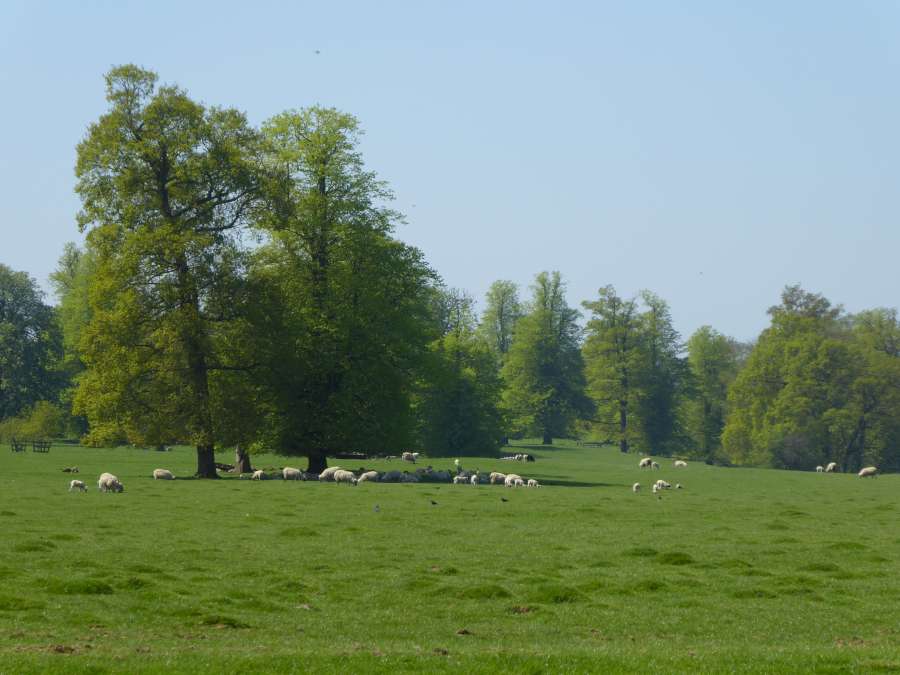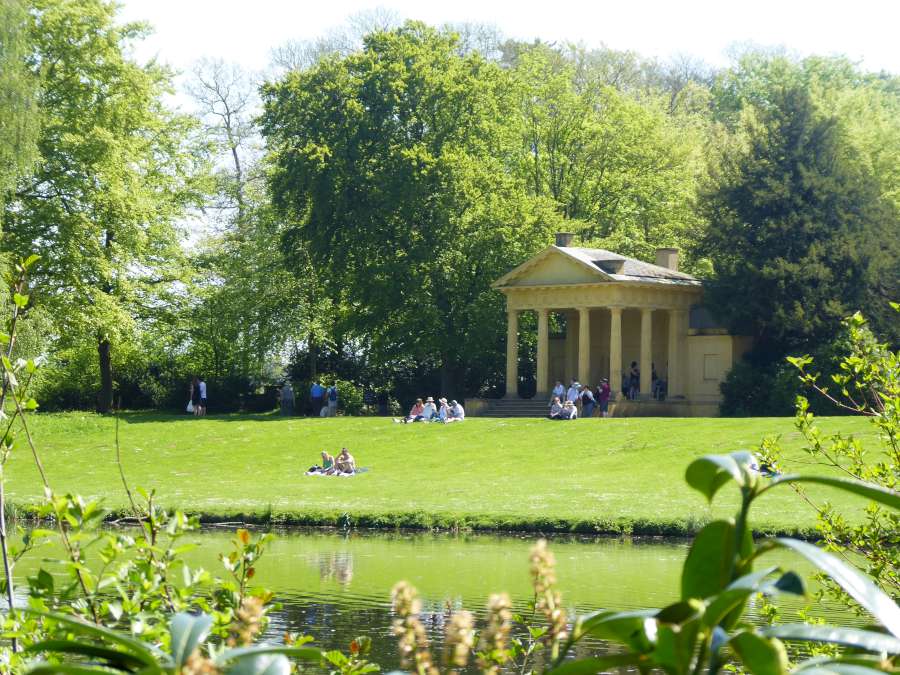Even earlier than uni, in my teens, a friend had invited me round to her hometown and showed me another very famous example of "not that kind of garden". In fact, the garden realm at Dessau-Woerlitz in Germany, now a UNESCO world heritage site, was directly inspired by Stowe as far as I know. I remember going and finding myself mightily disappointed: Where were those famous gardens?? It was November and hence not the best time for garden visiting anyway, but back then the only gardens you'd go "visit" I knew were stately Baroque-style affairs, formal in style (think Versailles), with many sculptures and box parterres etc. Here: nothing of that sort. Just some clumps of trees, rolling acres of grass and lakes, a few bridges...
Obviously, these are the classic elements of an English landscape garden. As the guidebook to Stowe continues: "Though there are a few formal flowerbeds within the balustrade on the south side of the house, all beyond is a picture of idealised nature, whose elements are grass and trees and water, with buildings carefully sited to give accents to the view and allow the wandering eye a resting place." So, yes - in order to appreciate it as a "famous garden" or indeed a "garden" at all, you'd better have at least a rough idea about the English landscape garden movement, its origins, principles and place in history.
"Created by Viscount Cobham in the grounds of his family home, the garden came to reflect a coherent programme of ideas based on Cobham's hugely influential network of political affiliations, and it was realized by that eighteenth-century master of garden design, William Kent. Encapsulating an idealised Whig vision of constitutional monarchy and political freedom, the garden featured a series of extraordinary and innovative garden buildings, designed by the leading architects of the day and ranging from the Temple of Ancient Virtue and a Rotondo to Lake Pavillions, a Chinee House and a Grotto, all set in carefully constructed Arcadian landscape of valleys and lakes."
But you do not need to know any of this in order to enjoy the place as a destination! Whether you know the landscape was deliberately made to appear like that or not does not inhibit your enjoyment of it. As with most art forms, such as music, architecture or furniture making, knowledge adds a layer, enhances or deepens your enjoyment - but merely that. For even as a total ignoramus you cannot fail to be charmed by this "landscape", to breath deeply and congratulate yourself for coming here with your picnic blanket for a relaxing and recharging day out. My daughter - who'd previously tried mutiny on learning we'd be going to a garden rather than the seaside - was instantly swayed and forgot to complain.
In fact, many of the follies are quite ugly close up - roughly executed, to be admired from afar rather than appreciated at close quarters. I can't help but feel the owners either ran out of money or wanted to avoid just that, suddenly aware even they had to keep an eye on the budget: "Build me a temple there, will you? Should look like the real thing from across the lake - but don't worry about execution of the finer details, would be a waste of money as we won't use it for anything else anyway. No one's ever getting that close and anyway, it's the idea that counts." These buildings (in the sense of "a thing that has been built") look as if the builders have finished and left but the interior architects/ decorators haven't moved in yet.
But they do work a treat in the way they were intended. Walking around the landscaped garden, they suddenly pop up as if out of no-where, to such an effect as to often cause your jaw to drop. Again and again I've found myself marvelling at the skill of the person devising these axes. Even though you know where e.g. the Rotunda is - you've glimpsed it through semi-bare trees before - you won't see it for several minutes along the way until you suddenly come to a point where it is revealed to full stunning effect that couldn't be more beautiful even if one tried (which, of course, is what they did and aimed for!).
It has to be one of the loveliest forms of Political PR imaginable! And - just a thought - one of the most powerful and persuasive as it is immersive and engages most of your senses in a setting where your senses are most open to any stimulation? So - any landowner keen follow suit and make a political statement for our day and age? Somehow I can only imagine a good example for "Remain" rather than "Brexit" (in the British case), for "inclusiveness and reaching out" rather than what "Trumpism" stands for.
What would the modern equivalent of political PR in a garden be like?
As the guidebook tells me, Stowe's Palladian Bridge for instance was decorated with sculptural reliefs stressing the importance of trade British prosperity. Based on fact rather than wishful thinking that would point to a "Remain" vote then? Actually, I think you could conceivably claim Stowe for either side of the contemporary argument. And it is void, of course, because those were different times, different politics, different sentiments and totally different competing ideas anyway. It would be grossly absurd and plain wrong to link Stowe's creators to either faction of today's big divide. It's tempting to make the comparison - but I'm only doing it via association of thought, purely speculatively, rather than claiming there is any connection, any actual relevance here.
The National Trust's guide book again: " 'What does the garden mean?' is hardly ever asked. For the concept that a garden as large as Stowe could have a specific and detailed programme of meaning - a sort of philosophic or political manifesto on the ground - is alien to our way of thinking." Still: It could be fun imaging what either could look like, though I wouldn't want to waste any time on that when lying underneath a tree in fresh leaf, gazing up into that juicy green and vivid blue.


























 RSS Feed
RSS Feed